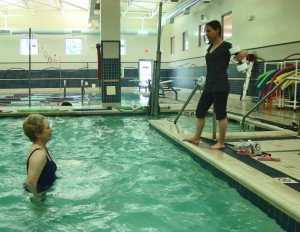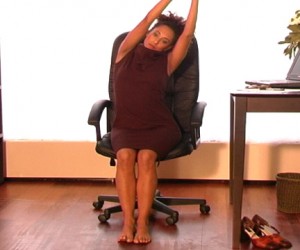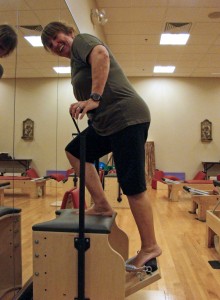by Michelle Sutton-Kerchner
Whether you own a bum knee or earned an injury while raking leaves, the results are the same. Days spent stiff, sore, and waiting for the next dose of ibuprofen. Nights spent tossing around, trying to get comfortable. Should you exercise or wait until this flare-up calms down …
Keep Moving but Keep It Safe
Bed rest with limited activity is a prescription of the past. Current research proves remaining active–within safe parameters– delivers the best outcome. When you minimize exercise during an episode of pain, your body quickly becomes deconditioned. Over time, small tasks like shampooing your hair or grocery shopping become daily obstacles. Fatigue and stiffness are associated with everything you do. The painful area is almost like a contagion that spreads over your entire being.
Go gently. Light exercise is beneficial and better than none at all. Perhaps you spent years as a runner or team champion. A simple walk on the treadmill might seem like baby stepping. Remind yourself that any form of physical activity during this time is helpful. Circulation helps the healing process. Movement loosens achy joints and tight muscles. It keeps you in the game, even if you aren’t fully playing.
Incorporate intervals of stretching throughout the day. Throw in a sprint around the office or house to raise your heart level. Frequency is more significant than duration when you’re suffering ongoing pain. It is not the time for increasing endurance. Focus on mild movements.

A personal trainer provides tools and exercises useful when overcoming an injury or trying to deal with chronic pain. Target muscles surrounding the painful area. Strengthening the neighboring muscles and joints supports the origin of pain. A trainer can also work on eliminating over-compensation issues. A balanced workout may still be possible, even if a left foot or right shoulder is under repair.
Members often find relief in yoga or T’ai Chi classes. Practice deliberate moves that increase strength and flexibility, along with breathing techniques. It’s a formula for pain control not found in the pharmacy. Notify your Group Fitness instructor of any pain prior to joining a class. S/he can work to customize the routine to fit your needs.
Water Therapy
Think of aquatic therapy as a training program for your training program. Progress your capabilities in the water, where decreased pain motivates progress.
Benefit from the Center’s aquatic offerings. Hydrotherapy is the safest, most comfortable method of fitness when in pain. Reduced effects of weight and gravity allow easier movement. Pain is better tolerated in the water’s buoyancy, without the gravitational load. Consider working with a personal trainer in the pool to assure a complete workout. Visit the Center’s Web site for each trainer’s biography to discover who is specialized in aquatic training.
Those suffering from chronic pain find the water soothing. It’s surprising to discover greatly increased functionality in the pool. Although you may not be able to accomplish an aerobic workout on land, it may be tolerable in the water.
Grab the pool’s edge or use a kickboard for support while fluttering legs at your own pace to elevate heart rate. The water’s light resistance helps simultaneously strengthen. Dangle from a water noodle. This allows the spine to decompress. Cycle legs in this position to prepare you for stationary cycling on the Exercise Floor.
If all this seems too strenuous, simply walk the pool’s shallow end. Go forward, backward, and sideways to find your most comfortable direction. Practice balancing on one foot, if you aren’t ready for aquatic walking yet. The further you progress in water, the easier your transition to land work.
At the end of any fitness session, whether or not your back is screaming or your joints are burning, soak in the Center’s hot tub. This alleviates negative energy from the body as it calms and loosens. You deserve an ahhhh-moment.
Work Woes

According to Pain Management Specialist Dr. Moshe Lewis, who is in private practice in California, “Movement is an effective mode of avoiding or eliminating pain in the workplace.” He continues, “Workers should walk around or at least stand up and stretch in place frequently, if they are unable to leave their desks.” Consistent gentle activity throughout the day allows you to stay ahead of chronic pain rather than exacerbating it with inactivity.
Chronic pain is a frequent issue at the workplace. Most cannot afford to use sick time for an ongoing back ache or sore shoulder. This leads to employees dragging around the office distracted by pain and dulled from pain killers. Avoid aggravating the situation with poor posture. Be sure your desk is ergonomically situated, with chair and computer screen at the right height, and lumbar and wrist support in place. Thirty percent of workers’ compensation claims are a result of work-related musculoskeletal disorders, including carpal tunnel syndrome and tendonitis.
A Band-Aid for Boomers
Research proves people of all ages and physical conditions benefit from exercise. Some older adults fear exercise might be too strenuous, harmful, or exacerbate preexisting conditions. Often, ongoing aches and pains associated with aging are more likely from this mentality.
Don’t fear age; challenge it. Don’t baby yourself; care for yourself.

The National Institutes of Health confirm older adults hurt their health far more by being sedentary than by exercising. Restore your body, and perhaps even soothe away chronic soreness and stiffness, through an appropriate exercise program. Exercise and physical activity help maintain strength so you can minimize pain and continue to perform everyday tasks. A fitness routine enables you to enjoy life more, despite your age, shape, or that wretched back.
Homeopathic Suggestions
Depressing and frustration, dealing with chronic pain is also worrisome. In an attempt to sleep through the night or sit during a lengthy drive, medication is sometimes necessary. Acetaminophen and ibuprofen may be downed like vitamins by those in chronic pain, which becomes its own concern. Here are alternatives to help alleviate the daily intrusions caused by chronic pain.
- Aromatherapy: Massage with fragrant oils and herbs may decrease muscle pain, improve circulation, induce sleepiness, and soothe the mind. No time for a massage? Light an aromatherapeutic candle.
- Acupuncture can be successful, especially in reducing stiffness and tension. It may provide short-term relief by increasing blood flow to inflamed areas. Be sure the practitioner is experienced and reputable.
- Therapeutic massage done lightly and consistently may provide ongoing relief. Speak with the massage therapist about your sensitive areas and request a touch only as deep as your comfort zone allows. As you progress, deep tissue massage may become possible and beneficial.
- Get enough vitamin D, which can help reduce muscle aches. Experts indicate up to 5000 international units (IUs) daily is safe. Talk with your physician about this increase.Take with food for optimum absorption. You also get a boost automatically from sun exposure. Yet another reason why pain worsens in dreary, damp weather.
Don’t Let Pain Define You
Defy your pain. Don’t snuggle up with it on the couch, soothing yourself with bon-bons and rerun TV shows. Practice a healthy lifestyle. With a healthy weight, consistent and appropriate exercise, and proper nutrition you can manage chronic pain. You may even find yourself overcoming it.
Sources
“6 Ways to Get Through a Painful Work Day,” by Wyatt Myers at www.everydayhealth.com.
“8 Drug-Free Ways to Treat Fibromyalgia,” by Beth W. Orenstein at www.everydayhealth.com.
“Aging Gracefully: The Benefits of Exercise for Older Adults,” by Sharon O’Brien at www.about.com.
“Is It Safe for Me to Exercise If I Have Chronic Pain?” by Erica Jacques at www.about.com.
“Pool Therapy for Pain,” by Christina Lasich at www.healthcentral.com.
Image Credits
Pulled neck (introductory photo): © Darrengreen at www..Dreamstime.com
Side Stretch: www.flickr.com/photos/myyogaonline/457339544
 Fitness & Wellness News Your Source for Fitness News, Wellness News, Health News, and Nutrition News!
Fitness & Wellness News Your Source for Fitness News, Wellness News, Health News, and Nutrition News!



